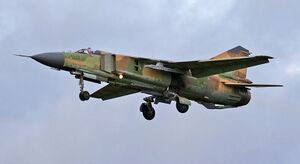AFASF-10 Donnola Air Superiority Fighter
This article is incomplete because it is pending further input from participants, or it is a work-in-progress by one author. Please comment on this article's talk page to share your input, comments and questions. Note: To contribute to this article, you may need to seek help from the author(s) of this page. |
| Ersilia AFASF-10 Donnola | |
|---|---|

| |
| A Ruvelkan Donnola on approach to land. | |
| Role | Fighter aircraft |
| National origin | |
| Manufacturer | Ersilia Defense and Aeronautics |
| First flight | 2 April 1962 |
| Introduction | 10 June 1965 |
| Retired | 5 May 1985 (CRAF; as fighter) |
| Status | In limited service |
| Primary user | |
| Produced | 1962—1986 |
| Unit cost |
ɫ6,100,000
|
The Ersilia AFASF-10 Donnola (Weasel) is a third-generation, variable-sweep wing fighter aircraft that was designed by Ersilia Defense and Aeronautics in the 1960s. It was the first Cacertian aircraft equipped with a look-down/shoot-down radar and beyond-visual-range missiles. The Donnola served as the mainline fighter of the Cacertian Royal Air Force from its introduction in 1965 until being replaced by the AFASF-12 Drago in 1983.
Large numbers of the Donnola were sold to Ruvelka in the early 1970s where it also served as the Imperial Air Force’s main fighter aircraft. While it has largely been superseded by Dragos in RIAF service, large portions of the Donnola fleet were pressed into service during the Zemplen War with many serving as reconnaissance and electronic warfare aircraft. They continue to serve in a limited role in the RIAF today.
Development
Design
Operation History
Variants
- AFASF-10
The original production variant of the Donnola.
- AFASF-10EW
The 10EW is an electronic warfare variant of the Donnola that first entered service with the Cacertian Royal Navy in 1971. It was developed at the request of the Navy for a carrier-based electronic warfare and electronic countermeasure aircraft to support a carrier strike wing's fighters. It was later adopted by the Air Fleet in 1973 and is in the only variant of the Donnola still in service with the Cacertian Armed Forces.
Operators
Current Operators
 Cacerta; Cacertian Royal Air Fleet, Cacertian Royal Navy—The electronic warfare variant of the Donnola remains in service with both the Air Fleet and Navy.
Cacerta; Cacertian Royal Air Fleet, Cacertian Royal Navy—The electronic warfare variant of the Donnola remains in service with both the Air Fleet and Navy. Ruvelka; Ruvelkan Imperial Air Force—166 currently listed as part of the RIAF’s inventory. Many of these remaining Donnola’s have been converted to house advanced ECM suites.
Ruvelka; Ruvelkan Imperial Air Force—166 currently listed as part of the RIAF’s inventory. Many of these remaining Donnola’s have been converted to house advanced ECM suites.
Former Operators
 Cacerta; Cacertian Royal Air Fleet—The CRAF retired the Donnola as a frontline faighter in 1985. Much of its fleet was converted, sold, or scrapped.
Cacerta; Cacertian Royal Air Fleet—The CRAF retired the Donnola as a frontline faighter in 1985. Much of its fleet was converted, sold, or scrapped.
Specifications
General Characteristics
- Crew: 1
- Length: 16.7 m (54 ft 9 in)
- Wingspan: 13.97 m (45 ft 10 in) fully spread; 7.78 m (25 ft 6 in) fully swept
- Height: 4.82 m (15 ft 10 in)
- Wing Area: 37.35 m² (402 ft²) fully spread; 34.16 m² (367.16 ft²) fully swept
- Gross Weight: 14,840 kg (32,717 lbs)
- Max Takeoff Weight: 17,800 kg (39,242 lbs)
- Powerplant: 1 × EDA-1962 Afterburning Turbojet
Performance
- Maximum Speed: Mach 2.35 (2,499 km/h, 1,553 mph) at altitude
- Range: 1,900 km (1,200 mi, 1,000 nmi)
- Combat Range: 1,500 km (930 mi, 810 nmi) with standard weapons load; 2,550 km (1,580 mi, 1,380 nmi) with standard weapons load and three drop-tanks
- Ferry Range: 2,820 km (1,750 mi, 1,520 nmi) with three drop-tanks
- Service Ceiling: 18,300 m (60,000 ft)
- Rate of Climb: 230 m/s (45,000 ft/min)
Armament
- Guns: 1 × 23 mm with 260 rounds
- Payload: 3,000 kg (6,600 lbs) across wing, wing-glove, and fuselage pylons